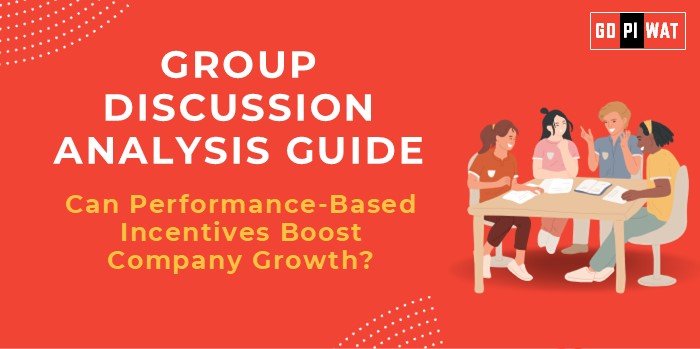📋 Group Discussion Analysis Guide
🌟 Topic: Can Performance-Based Incentives Boost Company Growth?
🌐 Introduction to the Topic
Opening Context: “In an increasingly competitive global economy, companies are under constant pressure to optimize productivity and profitability. Performance-based incentives are often viewed as a powerful tool to drive employee engagement, increase motivation, and align individual efforts with organizational goals.”
Topic Background: The concept of performance-based incentives stems from behavioral economics and organizational psychology, where rewards—monetary or non-monetary—are used to stimulate productivity. Prominent companies like Google, Infosys, and Tesla have leveraged performance-linked bonuses to achieve substantial growth. However, questions remain about its long-term effectiveness and potential drawbacks.
📊 Quick Facts and Key Statistics
- 🌍 Global Productivity Gains: Performance-linked incentive programs can increase productivity by 15-25% when effectively implemented (Gallup, 2023).
- 💼 Employee Retention: Companies with effective incentive programs report higher retention rates (20-30%) compared to firms without such plans (Deloitte, 2023).
- 🇮🇳 Indian Context: In 2023, 74% of Indian companies adopted performance-based bonuses to motivate employees (Mercer Survey).
- 📈 Incentive-Driven Growth: Businesses with well-designed incentives see 12-20% annual revenue growth on average (McKinsey Report).
- 👏 Impact of Non-Monetary Incentives: 80% of employees report increased satisfaction when recognized through non-monetary rewards like growth opportunities and public recognition (LinkedIn Workplace Report).
🏢 Stakeholders and Their Roles
- Employers: Design incentive structures to improve performance and meet company goals.
- Employees: Respond to incentives through increased effort, innovation, and productivity.
- HR Departments: Facilitate incentive programs and ensure fairness and transparency.
- Shareholders: Benefit from improved company performance and profitability.
- Customers: Gain from better quality of service or product due to motivated employees.
✔️ Achievements and Challenges
Achievements:
- 📈 Improved Employee Productivity: Performance incentives have been shown to improve workplace efficiency by up to 25%.
- ✨ Innovation Encouragement: Google’s “20% time” incentive policy allowed employees to dedicate time to personal projects, leading to innovations like Gmail and Google Maps.
- 💡 Higher Employee Engagement: Recognition and rewards lead to increased morale, with a 70% engagement boost in incentive-driven workplaces (Harvard Business Review).
- 💵 Revenue Growth: Tesla’s incentive-based production targets significantly improved Model 3 production rates, helping the company meet its 2020 output goals.
Challenges:
- ⚠️ Short-Term Focus: Incentives can encourage employees to focus on short-term goals at the cost of long-term strategy.
- 🔍 Unintended Consequences: Overemphasis on rewards can sometimes encourage unethical behavior, such as data manipulation or cutting corners.
- ❌ Inequitable Rewards: Perceived unfairness in reward distribution can harm morale and cause conflicts.
- 😓 Burnout and Stress: High targets linked to incentives may result in employee exhaustion and lower job satisfaction.
🌍 Global Comparisons
- 🇺🇸 USA: Companies like Salesforce effectively balance monetary rewards and career growth incentives to maintain productivity without burnout.
- 🇩🇪 Germany: Focuses more on skill development as a long-term incentive for employees.
- 🇯🇵 Japan: Combines performance bonuses with team-based rewards to promote collective growth.
🗂️ Structured Arguments for Discussion
- Supporting Stance: “Performance-based incentives align employee efforts with company goals, driving productivity and ensuring measurable progress.”
- Opposing Stance: “Excessive reliance on performance-based incentives can create stress, encourage unethical behavior, and undermine teamwork.”
- Balanced Perspective: “While incentives can motivate employees and boost company growth, their success depends on fair implementation, clear targets, and a focus on employee well-being.”
🗣️ Effective Discussion Approaches
- Opening Approaches:
- 📊 Start with a statistic: “Studies show that companies with structured incentive programs experience a 20% revenue boost on average.”
- 💡 Use an example: “Google’s innovative incentive strategies resulted in some of the most revolutionary products like Gmail.”
- Counter-Argument Handling:
- 💬 Address concerns of stress: “Performance incentives, when balanced with career growth and well-being initiatives, can prevent burnout.”
- 🔄 Handle fairness concerns: “Transparent criteria and feedback mechanisms ensure equitable rewards.”
🛠️ Strategic Analysis of Strengths and Weaknesses
- Strengths: Increases productivity, drives innovation, attracts talent, and improves revenue growth.
- Weaknesses: Risk of short-term focus, stress, and inequitable rewards.
- Opportunities: Tailoring incentives to include skill development and work-life balance.
- Threats: Unethical practices and employee disengagement if goals are unrealistic.
🎓 Connecting with B-School Applications
- Real-World Applications:
- Incentive strategies can inspire projects on human resource management, leadership, and organizational performance.
- Case studies on Tesla, Google, or Infosys can be explored in operations and strategy analysis.
- Sample Interview Questions:
- “How do performance-based incentives impact employee morale and productivity?”
- “Can incentives backfire and harm long-term company strategy?”
- Insights for B-School Students:
- Learn how to design balanced incentive systems that drive results without compromising ethics.
- Explore human resource strategies to foster innovation and retain talent.


